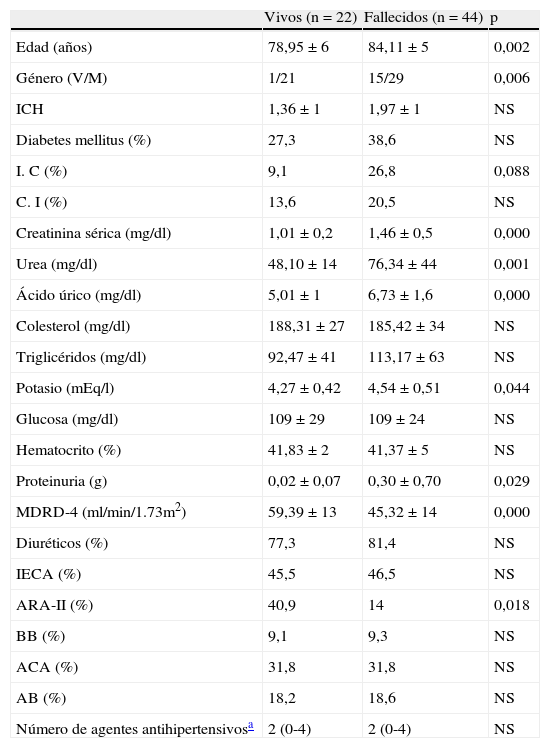La prevalencia de hipertensión arterial (HTA) en los ancianos es elevada. Su falta de control puede contribuir a un envejecimiento vascular precoz. Nuestro objetivo fue analizar, en ancianos diagnosticados de HTA y seguidos prospectivamente durante 6 años, la mortalidad, sus causas,y los predictores de mortalidad.
Pacientes y métodosEstudio observacional prospectivo, de 66 ancianos, reclutados aleatoriamente en consultas de Geriatría y de Nefrología entre enero y abril de 2006 y seguidos durante 6 años. La edad media de los pacientes era de 82,3 ± 6 años (rango 69-97), hubo 50 mujeres y 16 varones.
ResultadosUn total de 44 pacientes (66,6%) fallecieron a lo largo de los 6 años. Entre las causas conocidas de mortalidad, el deterioro progresivo del estado general (n=14) fue la principal causa, siendo menos frecuentes las cardiovasculares y el ictus (n=9). No se encontraron diferencias significativas en el número de agentes antihipertensivos ni en los tipos de fármacos usados en el periodo basal entre los vivos y fallecidos, excepto para los ARAII (menos usados en los exitus) (p=0,018).
En el análisis univariante de las características basales, los fallecidos eran significativamente más añosos (p=0,002), mayoritariamente varones (p=0,006), tenían peor grado de función renal (p=0,000) y mayores niveles de ácido úrico (AU) (p=0,000).
En el análisis de Cox, únicamente el género (p=0,029) y los niveles de AU basales (p=0,000) fueron predictores independientes de mortalidad.
ConclusionesEl género y el AU predicen mortalidad en nuestra cohorte de ancianos hipertensos en los que el deterioro progresivo de su estado general fue la principal causa de mortalidad.
The prevalence of high blood pressure (BP) in the elderly is high. Untreated hypertension can accelerate the rate of vascular aging. The aim of this study was to analyze, mortality, and the causes and predictors of mortality, in elderly patients with high BP and a 6-year follow-up.
Patients and methodsA prospective, observational study was performed in 66 elderly patients with high BP, who were randomly recruited in Geriatrics and Nephrology consultations between January and April 2006 and were followed-up for 6 years (second evaluation between January and April, 2012). The mean age of the patients was 82.3±6 years (range, 69-97 year), and there were 50 women and 16 men.
ResultsA total of 44 patients (66.6%) died during the 6-year follow-up. Among the known causes of mortality, the main cause was progressive deterioration in the patient's general health status (n=14), while less frequent causes were cardiovascular disease and stroke (n=9). No significant variations were found between survivors and nonsurvivors in the number of antihypertensive agents or in the types of drugs used in the baseline period, except for angiotensin II receptor blockers, which were less frequently used in nonsurvivors (P=.018).
In the univariate analysis of the baseline characteristics, nonsurvivors were significantly older (P=.002), were mostly men (P=.006), had greater renal function impairment (P=.000), and higher levels of serum uric acid serum (SUA) (P=.000). In the multivariate Cox analysis, the only independent predictors of mortality were sex (P=.029) and SUA levels (P=.000).
ConclusionsIn our cohort of hypertensive elderly patients, predictors of mortality were sex and SUA levels. The main cause of mortality was progressive deterioration in general health status.
Artículo
Comprando el artículo el PDF del mismo podrá ser descargado
Precio 19,34 €
Comprar ahora







